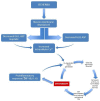Nitric Oxide and Lutein: Function, Performance, and Protection of Neural Tissue
- PMID: 28231230
- PMCID: PMC5224557
- DOI: 10.3390/foods4040678
Nitric Oxide and Lutein: Function, Performance, and Protection of Neural Tissue
Abstract
The soluble gas neurotransmitter nitric oxide (NO) serves many important metabolic and neuroregulatory functions in the retina and brain. Although it is necessary for normal neural function, NO can play a significant role in neurotoxicity. This is often seen in disease states that involve oxidative stress and inflammation of neural tissues, such as age-related macular degeneration and Alzheimer's disease. The dietary xanthophyll carotenoid lutein (L) is a potent antioxidant and anti-inflammatory agent that, if consumed in sufficient amounts, is deposited in neural tissues that require substantial metabolic demand. Some of these specific tissues, such as the central retina and frontal lobes of the brain, are impacted by age-related diseases such as those noted above. The conspicuous correspondence between metabolic demand, NO, and L is suggestive of a homeostatic relationship that serves to facilitate normal function, enhance performance, and protect vulnerable neural tissues. The purpose of this paper is to review the literature on these points.
Keywords: inflammation; lutein; nitric oxide; oxidative stress.
Figures



References
-
- Futterman S. Metabolism and Photochemistry in the Retina. In: Moses R.A., editor. Adler’s Physiology of the Eye. 6th ed. C.V. Mosby Company; St. Louis, MO, USA: 1975. pp. 406–419.
-
- Whikehart D.R. Biochemistry of the Eye. Butterworth-Heinemann; Boston, MA, USA: 1994. p. 73.
Publication types
LinkOut - more resources
Full Text Sources
Other Literature Sources

